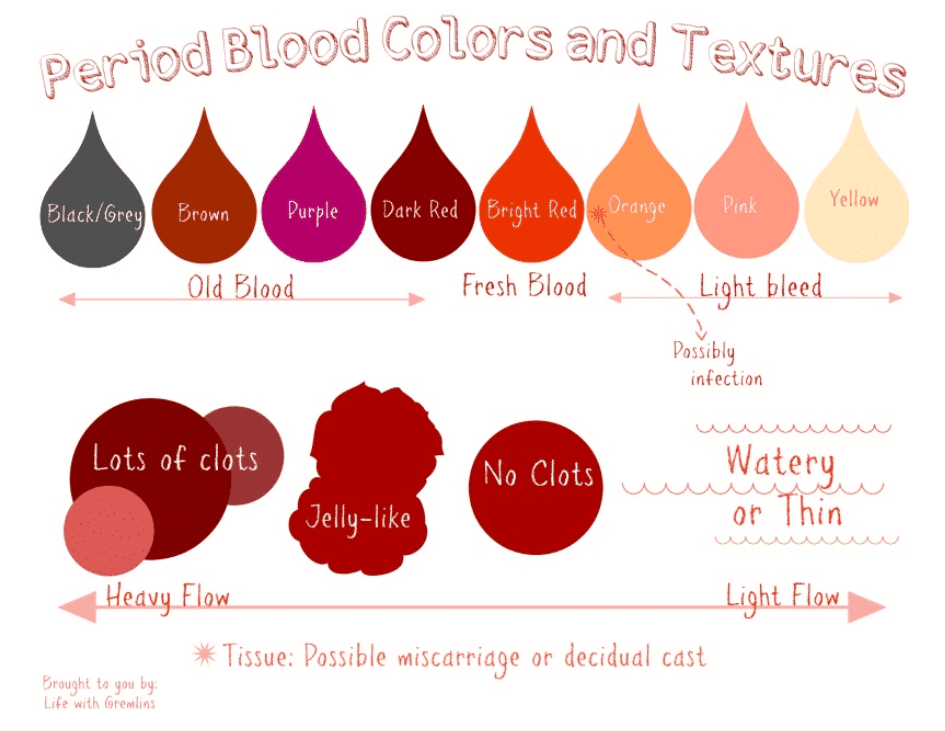What is Your Period Blood Telling You?
What is the colour and consistency of your period blood telling you about your health?
(Thanks to https://www.lifewithgremlins.com/ for this image!)
So many of us have been, or still are, grossed out by our period blood.
Too many women spend a bloody lot of time (excuse the period pun!) trying to disguise or ignore the fact that they are bleeding.
Even more women don’t look at or pay attention to their blood and dispose of it as quickly and discreetly as possible.
Don’t get me wrong, I think this is totally understandable given the cultural climate around menstruating that we’ve grown up in, and all of the shame and stigma surrounding this mysterious process of the female body.
But the shame and secrecy that women carry around with regards to their periods needs to be shed! - Just like their uterine walls each month!!
I’d bloody (sorry, can’t help it!) LUUUUURRVE to see more of us reclaiming our menstrual cycles, getting on the same team as our bodies, and kicking serious arse as a result of being empowered and informed about, and by, our incredible bods!!!
In fact, I’ve done a couple of awesome podcast episodes on my pod The Labia Lounge that cover this sort of thing that might blow your hair back:
How to Turn Your Menstrual Cycle Into a Superpower with Jema Lee
Exercising for Your Cycle and Natural Fertility Awareness Contraception with Dr. Madalyn Turner
There’s so much to be learned from our bleeds, and if you can get into the habit of observing what colour and consistency your blood is each month, you’ll have a barometer for health that will become invaluable.
So, wanna start gleaning info from your moon-time fuckin’ ASAP?!
Here’s How to Read What Your Period Blood is Telling You:
You’re going to want to start having a look at your blood regularly during your cycle to see what colour and consistency it is.
This is easiest when you use a moon cup, but is also possible with all other forms of blood collection.
Natural or fabric pads that are light in colour are great as a background to look at blood colour.
Tampons you can have a look at when you yoink them out.
Period panties are a bit trickier just because they are usually black, but you can use some toilet paper to catch your blood when you sit on the toilet each time you pee, or at least watch the blood as it drops into the toilet.
Try to get a good look one way or another!
Now, what does the colour of your menstrual blood mean??
You can have different colours of blood throughout your bleed and it’s still totally normal. This is because the longer the period blood is exposed to oxygen once it’s been shed from the endometrium, the darker it’ll be. So the faster your uterine lining sheds, the less blood is exposed to oxygen, and the brighter red the blood will be.
The shedding of your lining is slower at the beginning of your period, and faster during the middle. So this explains why you might have rusty red or brownish blood in the first day or two of your period.
(Read this post about Why You Should Track Your Menstrual Cycle and How)
I also have a free cycle tracking chart that you can start tracking your cycles with, as well as a gorgeous Menstrual Menu poster that tells you which foods are best to eat at each stage of your cycle! (This is a great gift idea for the conscious menstruator too, might I add!)
Black or grey period blood:
Black period blood sounds pretty alarming, yeah? Well not necessarily…
Usually at the beginning or end of your period and not in large quantities, this will probably just be older blood that has oxidised and changed colour. If bleeding is very light too, blood can take longer to make it’s way out which results in darker coloured blood.
Dark red or brown period blood:
Why is my period blood brown? - I get asked this a lot. Darker blood indicates normal, rising levels of oestrogen as well as a thicker uterine lining. As you start menstruating, your oestrogen starts to rise, so darker blood at this stage makes sense.
Brown discharge after birth is also very normal.
However, dark brown bleeding can also be a hallmark of PCOS so if you experience brown bleeding the whole way through your period (as opposed to just at the start and end) coupled with irregular periods, cystic acne, weight gain, unusual hair growth and/or infertility you should go get screened for this.
Bright red period blood:
Bright red blood? This indicates a normal, healthy flow. Your uterine lining is shedding at a good pace, the oxygenation rate is ace, you have few clots and inflammation is low.
Pink/orange period blood:
Light coloured period blood that appears watered down may indicate depletion. It could be nutrient deficiencies or under-eating (particularly not enough healthy fats), or low oestrogen due to overwhelm, chronic stress or burn out.
It can also indicate signs of an infection or anaemia.
However, sometimes this is simply from cervical mucus mixing with the blood which is totally normal, so paying attention to how often and how long you bleed this lighter coloured fluid is important for context.
Pink period blood when you’re over 40 can also just mean that you’re starting to see lower levels of oestrogen and can be an indicator of perimenopause.
And lastly, if you get a bit of pink spotting midway through your cycle, this is a normal and healthy indicator that you’re ovulating that some women get. No cause for concern, just a little side effect of popping out an egg!
Purple period blood:
Excess levels of oestrogen which can be managed using diet and lifestyle factors. The main one is usually upping your dietary fibre. Usually this colour isn’t a huge cause for worry, but if it is accompanied by large dark blood clots, sharp stabbing pains, intense period cramps or a super heavy flow then it could mean the possibility of endometriosis, fibroids, or possibly anaemia.
What does the consistency of my period blood mean though?
The viscosity of your period blood can be important to note too, and as a general rule of thumb it’s ideal if it’s a bit thicker than water and flows nice and freely.
Thick or clotted period blood:
A few clots here and there are totally chill. Small, stringy clots or clumpy blood can be absolutely normal, especially when your flow is at its heaviest. After all, chunks of your uterine lining are shedding and falling out your vagina! If a lot of this is happening at once or your flow is heavy, it’s understandable that there may be some congealed bits of thick blood, tissue and cells. This is because as blood is expelled, the body releases anti-coagulates to prevent the blood from clotting so it can flow out more easily. But if your bleed is heavy, the anti-coagulates don’t have enough time to work their magic, resulting in clots. They are also usually of a darker colour blood, though not always.
Clots bigger than the size of a quarter or a large quantity of period clots that you can feel as they pass can signal an issue. This might be a sign of hormonal imbalance, or a uterine fibroid or endo. Get it checked out to be safe, m’dear, cos at the end of the day, this blog post isn’t medical advice!
Thin and watery period blood:
This can just mean new blood flowing quickly from the uterus at the beginning of your bleed, or a light, low flow at the end of it. Fresh blood is thinner, and means the anti-coagulants have done their work. But if it’s like this in the middle of your period when it’s not usually, it can also mean low oestrogen or can be a sign of anemia.
Again, being clued onto how your body usually bleeds each month provides valuable context and can help you recognise when something is amiss.
It’s sometimes indicative of malnutrition or a fallopian or ovarian tumour if your period blood gets thinner over two or three cycles.
Any kind of hormonal birth control can also cause this type of bleed.
Stringy period blood or blood with bits of tissue in it:
Stringiness is another type of mild clotting that isn’t anything to worry about. There can also be actual tissue or part of your uterine lining coming out in your menstrual blood. This sounds gnarly but is actually quite normal as long as it’s not in massive amounts.
On rare occasions there can actually be something called a decidual caste which is part of the mucous membrane of the uterus and can shed in small, stringy chunks or as a whole “chicken skin”-like piece in the shape of the uterus. This can be a sign of hormonal imbalance or ectopic pregnancy and is most common in women who are using hormonal birth control.
Definitely seek some further professional support if you have continued pain after this happens.
Lastly, miscarriage tissue can sometimes be found in the period and is commonly described as grey to white in colour. It doesn’t look like a normal blood clot, but isn’t necessarily anything to worry about. Our bodies strategically miscarry for us way more than we realise!
Slippery, jelly-like period blood or mucus in menstrual blood:
Probably just because cervical mucus is mixing with the blood on its way out. No reason for alarm!
Especially if your period is light, the presence of cervical mucus can be enough to alter the texture or colour of your period blood.
If you’ve just done a poo, this may have pushed out more cervical fluid too, or if you’ve recently been pregnant you might notice this mucus-y blood.
There you have it!
So many perfectly normal and explainable ways that your menstrual blood can differ, and some telltale signs of imbalance to keep an eye out for.
Hopefully this empowers you to keep tabs on your health through your period and you can pick up on any abnormalities as they present themselves!
*** Traditional Chinese Medicine also has a whole model on menstrual blood that can tell you specifically in the body where there may be an issue and signal what’s going on in other areas of your health based on what your period is doing. So I suggest hitting up a TCM doc if there’s something to work on with your health that needs extra, specialised support. ***
Happy blood gazing, my lovely lumps!
May you monitor your period with joy, curiosity, and love henceforth! xxx


